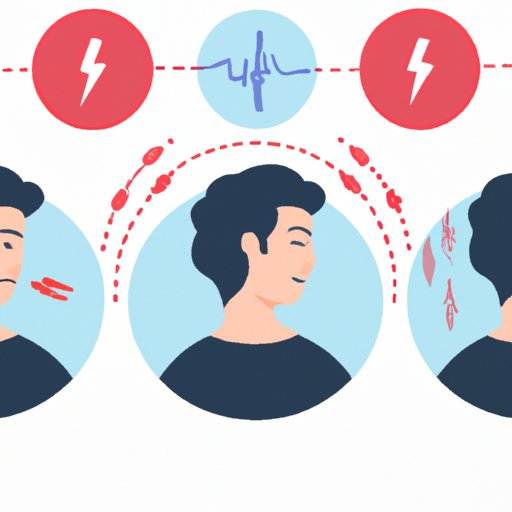
I. Introduction
Feeling nervous is a common problem that many people experience from time to time. Whether it’s before a big presentation, job interview, or a social gathering, nerves can be overwhelming. In this article, we will discuss techniques and tips for how to calm nerves.
II. The Importance of Calming Nerves
When we are nervous, our bodies respond by releasing stress hormones such as cortisol and adrenaline, causing physical and mental changes. These changes can have a negative impact on our health ranging from increased heart rate and blood pressure to disrupted sleep. Learning how to calm nerves can have many benefits including improved mental and physical health, better performance, and more enjoyable experiences.
III. Deep Breathing Techniques
Deep breathing is a simple and effective technique for reducing feelings of nervousness. It involves taking slow, deep breaths from the belly. This technique is easy to practice and can be done anywhere, anytime.
Here’s how to practice deep breathing:
- Find a comfortable seated position and place your hands on your belly.
- Inhale slowly through your nose, expanding your belly as you breathe in.
- Exhale slowly through your mouth, contracting your belly as you breathe out.
- Repeat for a few minutes, focusing on your breath and allowing yourself to relax.
Benefits of deep breathing include reduced heart rate and blood pressure, increased relaxation, and improved focus.
IV. Mindfulness Meditation
Mindfulness meditation is a technique that involves focusing on the present moment and observing thoughts and sensations without judgment. It can help reduce feelings of anxiety and promote overall well-being.
To practice mindfulness meditation:
- Find a quiet and comfortable place to sit.
- Close your eyes and focus on your breath.
- Observe your thoughts without judgment as they come and go.
- When your mind wanders, gently bring your attention back to your breath.
- Continue for a few minutes, gradually increasing the duration of your practice.
Benefits of mindfulness meditation include reduced anxiety and stress, improved focus and concentration, and increased self-awareness.
V. Physical Exercise
Physical exercise is an effective way to reduce feelings of nervousness and improve overall health. Exercise releases endorphins, which can help relieve stress, boost mood, and improve sleep quality.
There are many types of exercises to choose from including:
- Cardiovascular exercise such as running, walking, or cycling
- Strength training with weights or resistance bands
- Yoga or Pilates for flexibility and relaxation
It’s important to choose an exercise that you enjoy and that fits into your schedule. Aim for at least 30 minutes of exercise per day, five days a week.
VI. Cut Back on Caffeine
Caffeine is a stimulant that can increase feelings of nervousness and anxiety. If you are prone to nervousness, consider cutting back on caffeine.
Alternative drinks that can provide a calming effect include:
- Herbal tea
- Decaffeinated coffee or tea
- Natural fruit juices
- Water
It’s important to stay hydrated throughout the day, so make sure to drink plenty of water.
VII. Listening to Soothing Music
Music can have a powerful effect on our mood and emotions. Listening to soothing music can help reduce feelings of nervousness and promote relaxation.
Here are some types of music that can have a calming effect:
- Classical music such as Mozart or Beethoven
- Nature sounds such as ocean waves or birds chirping
- Music specifically designed for relaxation
Listening to music can be incorporated into daily life by playing music during a commute, while doing household chores, or during a bath or shower.
VIII. Progressive Muscle Relaxation
Progressive muscle relaxation is a technique that involves tensing and then relaxing different muscle groups in the body. It can help reduce feelings of tension and promote relaxation.
To practice progressive muscle relaxation:
- Find a comfortable place to lie down or sit.
- Tense and hold a muscle group for five seconds.
- Release the tension and relax the muscle group for ten seconds.
- Move on to the next muscle group and repeat the process until you have gone through all the muscle groups in your body.
Benefits of progressive muscle relaxation include reduced muscle tension and stress, improved sleep, and increased relaxation.
IX. Visualization Techniques
Visualization techniques involve imagining a calm and peaceful scene in your mind. It can help reduce feelings of nervousness and promote relaxation.
To practice visualization:
- Find a comfortable place to sit or lie down.
- Close your eyes and imagine a calm and peaceful scene, such as a beach or forest.
- Visualize the scene in detail, using all your senses.
- Allow yourself to relax and enjoy the peaceful scene.
Benefits of visualization include reduced stress and tension, improved focus and concentration, and increased relaxation.
X. Conclusion
In conclusion, feeling nervous is a common problem that can have negative effects on both our physical and mental health. Learning how to calm nerves can have many benefits, including improved mental and physical health and more enjoyable experiences. We discussed a variety of techniques, from deep breathing and mindfulness meditation to physical exercise and visualization techniques. Remember to choose techniques that work for you and incorporate them into your daily routine. Here’s to a more peaceful life!
Final thoughts and tips: It’s important to remember that calming nerves is a process, and it may take time to find the techniques that work best for you. Be patient and consistent in your practice. If you continue to experience feelings of nervousness that interfere with your daily life, consider seeking professional help.




